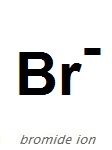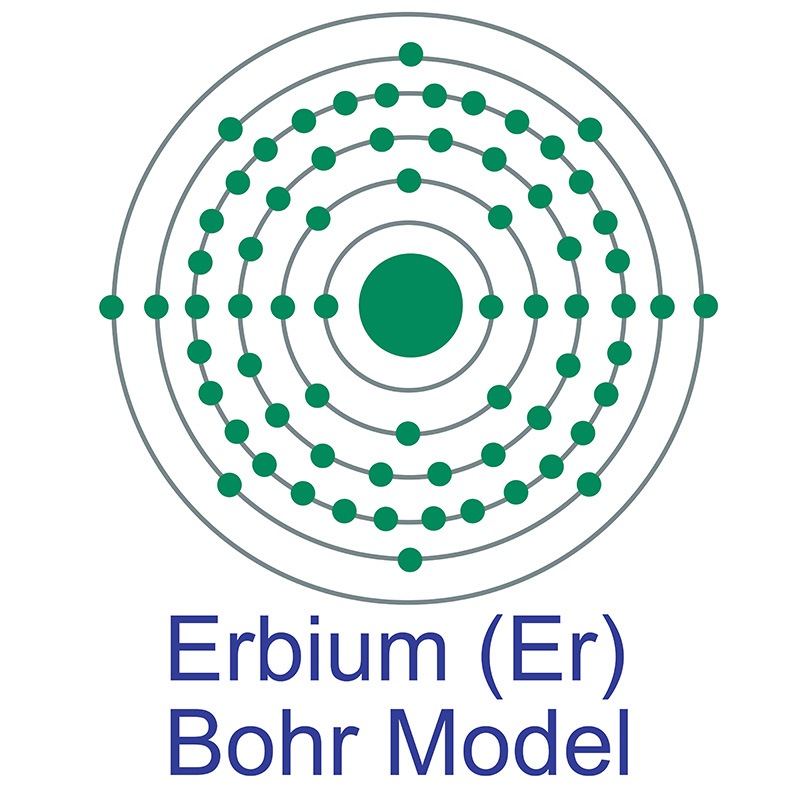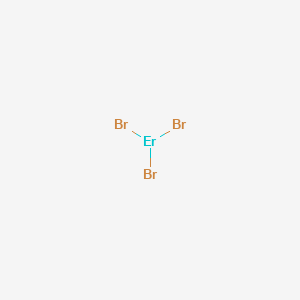SECTION 1. IDENTIFICATION
Product Name: Erbium Bromide
Product Number: All applicable American Elements product codes, e.g. ER-BR-04
, ER-BR-05
, ER-BR-02
, ER-BR-03
CAS #: 13536-73-7
Relevant identified uses of the substance: Scientific research and development
Supplier details:
American Elements
10884 Weyburn Ave.
Los Angeles, CA 90024
Tel: +1 310-208-0551
Fax: +1 310-208-0351
Emergency telephone number:
Domestic, North America: +1 800-424-9300
International: +1 703-527-3887
SECTION 2. HAZARDS IDENTIFICATION
Classification of the substance or mixture
GHS Classification in accordance with 29 CFR 1910 (OSHA HCS)
Skin irritation (Category 2), H315
Eye irritation (Category 2A), H319
Specific target organ toxicity - single exposure (Category 3), Respiratory system, H335
GHS Label elements, including precautionary statements
Pictogram

Signal word Warning
Hazard statement(s)
H315 Causes skin irritation.
H319 Causes serious eye irritation.
H335 May cause respiratory irritation.
Precautionary statement(s)
P261 Avoid breathing dust/ fume/ gas/ mist/ vapours/ spray.
P264 Wash skin thoroughly after handling.
P271 Use only outdoors or in a well-ventilated area.
P280 Wear protective gloves/ eye protection/ face protection.
P302 + P352 IF ON SKIN: Wash with plenty of soap and water.
P304 + P340 IF INHALED: Remove victim to fresh air and keep at rest in a
position comfortable for breathing.
P305 + P351 + P338 IF IN EYES: Rinse cautiously with water for several minutes.
Remove contact lenses, if present and easy to do. Continue
rinsing.
P312 Call a POISON CENTER/doctor if you feel unwell.
P321 Specific treatment (see supplemental first aid instructions on
this label).
P332 + P313 If skin irritation occurs: Get medical advice/ attention.
P337 + P313 If eye irritation persists: Get medical advice/ attention.
P362 Take off contaminated clothing and wash before reuse.
P403 + P233 Store in a well-ventilated place. Keep container tightly closed.
P405 Store locked up.
P501 Dispose of contents/ container to an approved waste disposal
plant.
Hazards not otherwise classified (HNOC) or not covered by GHS - none
SECTION 3. COMPOSITION/INFORMATION ON INGREDIENTS
Substances
Formula : Br3Er
Molecular weight : 406.97 g/mol
CAS-No. : 13536-73-7
EC-No. : 236-895-1
No components need to be disclosed according to the applicable regulations.
SECTION 4. FIRST AID MEASURES
Description of first aid measures
General advice
Consult a physician. Show this safety data sheet to the doctor in attendance.
If inhaled
If breathed in, move person into fresh air. If not breathing, give artificial respiration.
Consult a physician.
In case of skin contact
Wash off with soap and plenty of water. Consult a physician.
In case of eye contact
Rinse thoroughly with plenty of water for at least 15 minutes and consult a physician.
If swallowed
Never give anything by mouth to an unconscious person. Rinse mouth with water. Consult
a physician.
Most important symptoms and effects, both acute and delayed
The most important known symptoms and effects are described in the labelling (see section
2) and/or in section 11
Indication of any immediate medical attention and special treatment needed
No data available
SECTION 5. FIREFIGHTING MEASURES
Extinguishing media
Suitable extinguishing media
Use water spray, alcohol-resistant foam, dry chemical or carbon dioxide.
Special hazards arising from the substance or mixture
Hydrogen bromide gas, Erbium oxides
Advice for firefighters
Wear self-contained breathing apparatus for firefighting if necessary.
Further information
No data available
SECTION 6. ACCIDENTAL RELEASE MEASURES
Personal precautions, protective equipment and emergency procedures
Use personal protective equipment. Avoid dust formation. Avoid breathing vapours, mist
or gas. Ensure adequate ventilation. Evacuate personnel to safe areas. Avoid breathing
dust.
For personal protection see section 8.
Environmental precautions
Do not let product enter drains.
Methods and materials for containment and cleaning up
Pick up and arrange disposal without creating dust. Sweep up and shovel. Keep in
suitable, closed containers for disposal.
Reference to other sections
For disposal see section 13.
SECTION 7. HANDLING AND STORAGE
Precautions for safe handling
Avoid contact with skin and eyes. Avoid formation of dust and aerosols.
Provide appropriate exhaust ventilation at places where dust is formed.Normal measures
for preventive fire protection.
For precautions see section 2.
Conditions for safe storage, including any incompatibilities
Keep container tightly closed in a dry and well-ventilated place.
Keep in a dry place.
Storage class (TRGS 510): 11: Combustible Solids
Specific end use(s)
Apart from the uses mentioned in section 1 no other specific uses are stipulated
SECTION 8. EXPOSURE CONTROLS/PERSONAL PROTECTION
Control parameters
Components with workplace control parameters
Contains no substances with occupational exposure limit values.
Exposure controls
Appropriate engineering controls
Handle in accordance with good industrial hygiene and safety practice. Wash hands
before breaks and at the end of workday.
Personal protective equipment
Eye/face protection
Safety glasses with side-shields conforming to EN166 Use equipment for eye
protection tested and approved under appropriate government standards such as
NIOSH (US) or EN 166(EU).
Skin protection
Handle with gloves. Gloves must be inspected prior to use. Use proper glove
removal technique (without touching glove's outer surface) to avoid skin contact
with this product. Dispose of contaminated gloves after use in accordance with
applicable laws and good laboratory practices. Wash and dry hands.
Body Protection
Impervious clothing, The type of protective equipment must be selected according
to the concentration and amount of the dangerous substance at the specific
workplace.
Respiratory protection
For nuisance exposures use type P95 (US) or type P1 (EU EN 143) particle
respirator.For higher level protection use type OV/AG/P99 (US) or type ABEK-P2 (EU
EN 143) respirator cartridges. Use respirators and components tested and approved
under appropriate government standards such as NIOSH (US) or CEN (EU).
Control of environmental exposure
Do not let product enter drains.
SECTION 9. PHYSICAL AND CHEMICAL PROPERTIES
Information on basic physical and chemical properties
a) Appearance Form: powder
b) Odour No data available
c) Odour Threshold No data available
d) pH No data available
e) Melting point/freezing point
Melting point/range: 923 °C (1693 °F) - lit.
f) Initial boiling point and boiling range
No data available
g) Flash point ()Not applicable
h) Evaporation rate No data available
i) Flammability (solid, gas)
No data available
j) Upper/lower flammability or explosive limits
No data available
k) Vapour pressure No data available
l) Vapour density No data available
m) Relative density No data available
n) Water solubility No data available
o) Partition coefficient: n-octanol/water
No data available
p) Auto-ignition temperature
No data available
q) Decomposition temperature
No data available
r) Viscosity No data available
s) Explosive properties No data available
t) Oxidizing properties No data available
Other safety information
No data available
SECTION 10. STABILITY AND REACTIVITY
Reactivity
No data available
Chemical stability
Stable under recommended storage conditions.
Possibility of hazardous reactions
No data available
Conditions to avoid
Avoid moisture.
Incompatible materials
Strong oxidizing agents, Strong acids
Hazardous decomposition products
Hazardous decomposition products formed under fire conditions. - Hydrogen bromide gas,
Erbium oxides
Other decomposition products - No data available
In the event of fire: see section 5
SECTION 11. TOXICOLOGICAL INFORMATION
Information on toxicological effects
Acute toxicity
No data available
Inhalation: No data available
Dermal: No data available
No data available
Skin corrosion/irritation
No data available
Serious eye damage/eye irritation
No data available
Respiratory or skin sensitisation
No data available
Germ cell mutagenicity
No data available
Carcinogenicity
IARC: No component of this product present at levels greater than or equal to 0.1% is
identified as probable, possible or confirmed human carcinogen by IARC.
ACGIH: No component of this product present at levels greater than or equal to 0.1% is
identified as a carcinogen or potential carcinogen by ACGIH.
NTP: No component of this product present at levels greater than or equal to 0.1% is
identified as a known or anticipated carcinogen by NTP.
OSHA: No component of this product present at levels greater than or equal to 0.1% is
on OSHA’s list of regulated carcinogens.
Reproductive toxicity
No data available
No data available
Specific target organ toxicity - single exposure
Inhalation - May cause respiratory irritation.
Specific target organ toxicity - repeated exposure
No data available
Aspiration hazard
No data available
SECTION 12. ECOLOGICAL INFORMATION
Toxicity
No data available
Persistence and degradability
No data available
Bioaccumulative potential
No data available
Mobility in soil
No data available
Results of PBT and vPvB assessment
PBT/vPvB assessment not available as chemical safety assessment not required/not
conducted
Other adverse effects
No data available
SECTION 13. DISPOSAL CONSIDERATIONS
Waste treatment methods
Product
Offer surplus and non-recyclable solutions to a licensed disposal company.
Contaminated packaging
Dispose of as unused product.
SECTION 14. TRANSPORT INFORMATION
DOT (US)
Not dangerous goods
IMDG
Not dangerous goods
IATA
Not dangerous goods
SECTION 15. REGULATORY INFORMATION
SARA 302 Components
No chemicals in this material are subject to the reporting requirements of SARA Title III,
Section 302.
SARA 313 Components
This material does not contain any chemical components with known CAS numbers that
exceed the threshold (De Minimis) reporting levels established by SARA Title III, Section
313.
SARA 311/312 Hazards
No SARA Hazards
Massachusetts Right To Know Components
No components are subject to the Massachusetts Right to Know Act.
Pennsylvania Right To Know Components
Erbium tribromide CAS-No.
13536-73-7
Revision Date
New Jersey Right To Know Components
Erbium tribromide CAS-No.
13536-73-7
Revision Date
California Prop. 65 Components
This product does not contain any chemicals known to State of California to cause cancer,
birth defects, or any other reproductive harm.
SECTION 16. OTHER INFORMATION
Safety Data Sheet according to Regulation (EC) No. 1907/2006 (REACH). The above information is believed to be correct but does not purport to be all inclusive and shall be used only as a guide. The information in this document is based on the present state of our knowledge and is applicable to the product with regard to appropriate safety precautions. It does not represent any guarantee of the properties of the product. American Elements shall not be held liable for any damage resulting from handling or from contact with the above product. See reverse side of invoice or packing slip for additional terms and conditions of sale. COPYRIGHT 1997-2022 AMERICAN ELEMENTS. LICENSED GRANTED TO MAKE UNLIMITED PAPER COPIES FOR INTERNAL USE ONLY.


 The number of electrons in each of Erbium's shells is [2, 8, 18, 30, 8, 2] and its electron configuration is [Xe]4f12 6s2. The erbium atom has a radius of 176 pm and a Van der Waals radius of 235 pm. Erbium was discovered by Carl Mosander in 1843. Sources of Erbium include the mineral monazite and sand ores. Erbium is a member of the lanthanide or
The number of electrons in each of Erbium's shells is [2, 8, 18, 30, 8, 2] and its electron configuration is [Xe]4f12 6s2. The erbium atom has a radius of 176 pm and a Van der Waals radius of 235 pm. Erbium was discovered by Carl Mosander in 1843. Sources of Erbium include the mineral monazite and sand ores. Erbium is a member of the lanthanide or  In its elemental form, erbium is soft and malleable. It is fairly stable in air and does not oxidize as rapidly as some of the other rare earth metals. Erbium's ions fluoresce in a bright pink color, making them highly useful for imaging and
In its elemental form, erbium is soft and malleable. It is fairly stable in air and does not oxidize as rapidly as some of the other rare earth metals. Erbium's ions fluoresce in a bright pink color, making them highly useful for imaging and 
